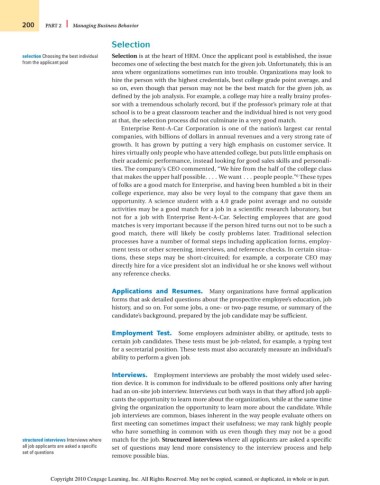Page 226 - Introduction to Business
P. 226
200 PART 2 Managing Business Behavior
Selection
selection Choosing the best individual Selection is at the heart of HRM. Once the applicant pool is established, the issue
from the applicant pool becomes one of selecting the best match for the given job. Unfortunately, this is an
area where organizations sometimes run into trouble. Organizations may look to
hire the person with the highest credentials, best college grade point average, and
so on, even though that person may not be the best match for the given job, as
defined by the job analysis. For example, a college may hire a really brainy profes-
sor with a tremendous scholarly record, but if the professor’s primary role at that
school is to be a great classroom teacher and the individual hired is not very good
at that, the selection process did not culminate in a very good match.
Enterprise Rent-A-Car Corporation is one of the nation’s largest car rental
companies, with billions of dollars in annual revenues and a very strong rate of
growth. It has grown by putting a very high emphasis on customer service. It
hires virtually only people who have attended college, but puts little emphasis on
their academic performance, instead looking for good sales skills and personali-
ties. The company’s CEO commented, “We hire from the half of the college class
that makes the upper half possible....We want . . . people people.” These types
6
of folks are a good match for Enterprise, and having been humbled a bit in their
college experience, may also be very loyal to the company that gave them an
opportunity. A science student with a 4.0 grade point average and no outside
activities may be a good match for a job in a scientific research laboratory, but
not for a job with Enterprise Rent-A-Car. Selecting employees that are good
matches is very important because if the person hired turns out not to be such a
good match, there will likely be costly problems later. Traditional selection
processes have a number of formal steps including application forms, employ-
ment tests or other screening, interviews, and reference checks. In certain situa-
tions, these steps may be short-circuited; for example, a corporate CEO may
directly hire for a vice president slot an individual he or she knows well without
any reference checks.
Applications and Resumes. Many organizations have formal application
forms that ask detailed questions about the prospective employee’s education, job
history, and so on. For some jobs, a one- or two-page resume, or summary of the
candidate’s background, prepared by the job candidate may be sufficient.
Employment Test. Some employers administer ability, or aptitude, tests to
certain job candidates. These tests must be job-related, for example, a typing test
for a secretarial position. These tests must also accurately measure an individual’s
ability to perform a given job.
Interviews. Employment interviews are probably the most widely used selec-
tion device. It is common for individuals to be offered positions only after having
had an on-site job interview. Interviews cut both ways in that they afford job appli-
cants the opportunity to learn more about the organization, while at the same time
giving the organization the opportunity to learn more about the candidate. While
job interviews are common, biases inherent in the way people evaluate others on
first meeting can sometimes impact their usefulness; we may rank highly people
who have something in common with us even though they may not be a good
structured interviews Interviews where match for the job. Structured interviews where all applicants are asked a specific
all job applicants are asked a specific set of questions may lend more consistency to the interview process and help
set of questions
remove possible bias.
Copyright 2010 Cengage Learning, Inc. All Rights Reserved. May not be copied, scanned, or duplicated, in whole or in part.

